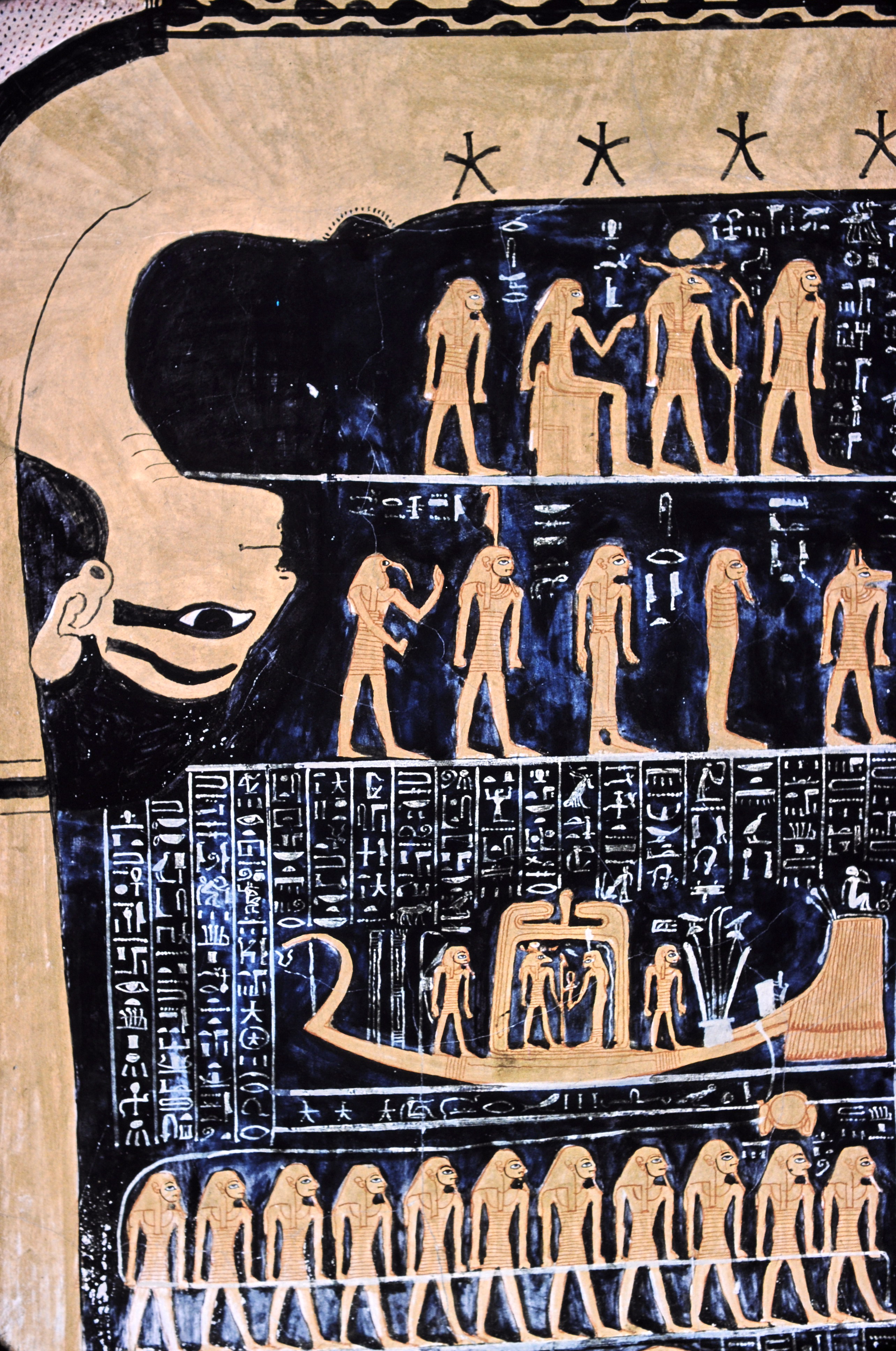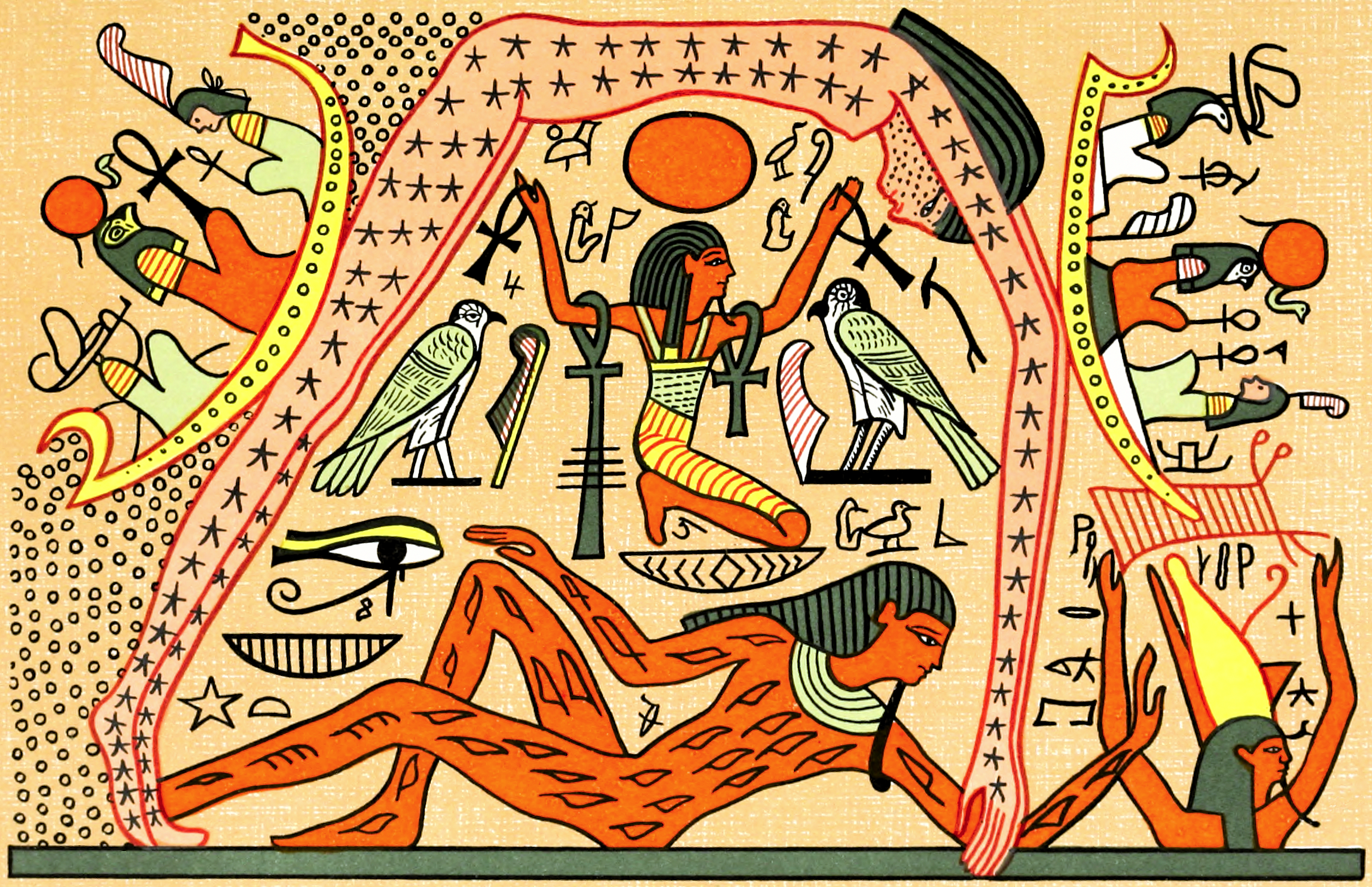Book Of Nut on:
[Wikipedia]
[Google]
[Amazon]
 The ''Book of Nut'' (original title: ''The Fundamentals of the Course of the Stars'') is a collection of
The ''Book of Nut'' (original title: ''The Fundamentals of the Course of the Stars'') is a collection of
 There are nine different copies of the book and they have various dates. Three copies are found on monuments and six more are found in the papyri of the second century AD found in the temple library in ancient
There are nine different copies of the book and they have various dates. Three copies are found on monuments and six more are found in the papyri of the second century AD found in the temple library in ancient
 The early Egyptologists gave a lot of attention to the astronomical parts of the ''Book of Nut''. First available for modern research was the material from the tomb of
The early Egyptologists gave a lot of attention to the astronomical parts of the ''Book of Nut''. First available for modern research was the material from the tomb of
ancient Egyptian
Ancient Egypt () was a cradle of civilization concentrated along the lower reaches of the Nile River in Northeast Africa. It emerged from prehistoric Egypt around 3150BC (according to conventional Egyptian chronology), when Upper and Lower E ...
astronomical texts focusing on mythological subjects, cycles of the stars of the decans
The decans (; Egyptian ''bꜣktw'' or ''baktiu'', "hoseconnected with work") are 36 groups of stars (small constellations) used in the ancient Egyptian astronomy to conveniently divide the 360 degree ecliptic into 36 parts of 10 degrees each, bo ...
, and the movements of the moon, sun, and planets on sundials
A sundial is a horology, horological device that tells the time of day (referred to as civil time in modern usage) when direct sunlight shines by the position of the Sun, apparent position of the Sun in the sky. In the narrowest sense of the ...
.
It is titled for the sky goddess Nut
Nut often refers to:
* Nut (fruit), fruit composed of a hard shell and a seed
* Nut (food), a dry and edible fruit or seed, including but not limited to true nuts
* Nut (hardware), fastener used with a bolt
Nut, NUT or Nuts may also refer to:
A ...
who is depicted in some copies of the text arching over the earth. She is supported by the god of the air Shu. Texts in the ''Book of Nut'' include material from different periods of Egyptian history.
The original name of the book, ''The Fundamentals of the Course of the Stars'', was discovered by Alexandra von Lieven in one of the manuscript fragments and published in 2007. One of the major themes of the ''Book of Nut'' is the concept of sunrise as the mythological rebirth.
Texts
 There are nine different copies of the book and they have various dates. Three copies are found on monuments and six more are found in the papyri of the second century AD found in the temple library in ancient
There are nine different copies of the book and they have various dates. Three copies are found on monuments and six more are found in the papyri of the second century AD found in the temple library in ancient Tebtunis
Tebtunis was a city and later town in Lower Egypt. The settlement was founded in approximately 1800 BCE by the Twelfth Dynasty king Amenemhat III. It was located in what is now the village of Tell Umm el-Baragat in the Faiyum Governorate. In Tebt ...
, a town in the southern Faiyum Oasis
The Faiyum Oasis ( ''Wāḥat al-Fayyum'') is a depression or basin in the desert immediately west of the Nile river, 62 miles south of Cairo, Egypt. The extent of the basin area is estimated at between 1,270 km2 (490 mi2) and 1,700&nb ...
. These include texts both in hieratic and demotic; some parts are written in hieroglyphs as well.
Three texts of the ''Book of Nut'' are preserved on monuments: the tomb of Ramses IV
Usermaatre Heqamaatre Setepenamun Ramesses IV (also written Ramses or Rameses) was the third pharaoh of the Twentieth Dynasty of the New Kingdom of Ancient Egypt. He was the second son of Ramesses III and became crown prince when his elder broth ...
, The Cenotaph of Seti I
Menmaatre Seti I (or Sethos I in Greek language, Greek) was the second pharaoh of the Nineteenth Dynasty of Egypt during the New Kingdom of Egypt, New Kingdom period, ruling or 1290 BC to 1279 BC. He was the son of Ramesses I and Sitre, and th ...
at the Osireion
The Osireion (or Osirion) is believed to be the cenotaph of located to the rear of the Temple of Seti I at Abydos, Egypt. The temple was built in the 13th century BC and many researchers believe the Osireion dates from the same period. Seti I ...
in Abydos, and the tomb of the noblewoman Mutirdis ( TT410) of the 26th Dynasty
The Twenty-sixth Dynasty of Egypt (notated Dynasty XXVI, alternatively 26th Dynasty or Dynasty 26) was the last native dynasty of ancient Egypt before the Persian conquest in 525 BC (although other brief periods of rule by Egyptians followed). T ...
. These monumental copies are written in hieroglyphs.
Currently, the Tebtunis textual material is scattered all over the world due to its complex excavation and acquisition history. There are several thousand fragments of unpublished papyri held by various museums that are being evaluated by scholars.
The most highly prized of the manuscripts are the demotic Carlsberg papyri 1, and 1a, because of their completeness. They were written by the same scribe. Other manuscripts are mostly fragmentary.
There are substantial differences among all of these copies, indicating that the textual tradition of the ''Book of Nut'' was still very much alive even in the second century AD.
History of scholarship
 The early Egyptologists gave a lot of attention to the astronomical parts of the ''Book of Nut''. First available for modern research was the material from the tomb of
The early Egyptologists gave a lot of attention to the astronomical parts of the ''Book of Nut''. First available for modern research was the material from the tomb of Ramses IV
Usermaatre Heqamaatre Setepenamun Ramesses IV (also written Ramses or Rameses) was the third pharaoh of the Twentieth Dynasty of the New Kingdom of Ancient Egypt. He was the second son of Ramesses III and became crown prince when his elder broth ...
, which included the astronomical painting of Nut and the list of the decans. The text was first used by Jean-François Champollion
Jean-François Champollion (), also known as Champollion ''le jeune'' ('the Younger'; 23 December 1790 – 4 March 1832), was a French philologist and orientalist, known primarily as the decipherer of Egyptian hieroglyphs and a founding figure ...
and Ippolito Rosellini
Niccola Francesco Ippolito Baldassarre Rosellini, known simply as Ippolito RoselliniBardelli 1843, p. 4 (13 August 1800 – 4 June 1843) was an Italian Egyptologist. A scholar and friend of Jean-François Champollion, he is regarded as ...
, later copied by Heinrich Brugsch
Heinrich Karl Brugsch (also ''Brugsch-Pasha'') (18 February 18279 September 1894) was a German Egyptologist. He was associated with Auguste Mariette in his excavations at Memphis. He became director of the School of Egyptology at Cairo, producin ...
. A new edition was issued in 1990 by Erik Hornung.
In 1933, The Cenotaph of Seti I at the Osireion
The Osireion (or Osirion) is believed to be the cenotaph of located to the rear of the Temple of Seti I at Abydos, Egypt. The temple was built in the 13th century BC and many researchers believe the Osireion dates from the same period. Seti I ...
in Abydos was discovered. This was important because this version represents the oldest text.
Adriaan de Buck's translation of the cryptographic sections of the ''Book of Nut'' significantly advanced the studies.
In 1977, Jan Assmann
Johann Christoph "Jan" Assmann (7 July 1938 – 19 February 2024) was a German Egyptologist, cultural historian, and religion scholar.
Life and works
Assmann studied Egyptology and classical archaeology in Munich, Heidelberg, Paris, and Göt ...
published another relevant text from the tomb of the noblewoman Mutirdis, dating to the 26th Dynasty.
Some important new material has been published since 2007.
Dates of composition
Most likely the ''Book of Nut'' text evolved over a long period of time going back before the time ofSeti I
Menmaatre Seti I (or Sethos I in Greek language, Greek) was the second pharaoh of the Nineteenth Dynasty of Egypt during the New Kingdom of Egypt, New Kingdom period, ruling or 1290 BC to 1279 BC. He was the son of Ramesses I and Sitre, and th ...
. The astronomical data included in the decan list below the body of Nut point to the 12th Dynasty
The Twelfth Dynasty of ancient Egypt (Dynasty XII) is a series of rulers reigning from 1991–1802 BC (190 years), at what is often considered to be the apex of the Middle Kingdom (Dynasties XI–XIV). The dynasty periodically expanded its terr ...
, the time of Sesostris III
Khakaure Senusret III (also written as Senwosret III or the hellenised form, Sesostris III) was a pharaoh of Egypt. He ruled from 1878 BC to 1839 BC during a time of great power and prosperity, and was the fifth king of the Twelfth Dynasty of the ...
.
There are two different decan lists that cannot be reconciled, so one of them must be secondary. According to von Lieven, the Middle Kingdom data is secondary, and she suggests that the earlier list goes back to the Old Kingdom
In ancient Egyptian history, the Old Kingdom is the period spanning –2200 BC. It is also known as the "Age of the Pyramids" or the "Age of the Pyramid Builders", as it encompasses the reigns of the great pyramid-builders of the Fourth Dynast ...
, the first of the three major divisions of dynasties.
See also
*Egyptian calendar
The ancient Egyptian calendar – a civil calendar – was a solar calendar with a 365-day year. The year consisted of three seasons of 120 days each, plus an Egyptian intercalary month, intercalary month of five epagomenal days treated as outs ...
Notes
Works cited
* * * * * * *Further reading
* * * * * *External links
* {{cite web , title=Inventory of Published Papyri , series=The Papyrus Carlsberg Collection , date=16 November 2008 , publisher=Københavns Universitet
The University of Copenhagen (, KU) is a public research university in Copenhagen, Denmark. Founded in 1479, the University of Copenhagen is the second-oldest university in Scandinavia, after Uppsala University.
The University of Copenhagen co ...
, place= Københavns, DK , url=http://pcarlsberg.ku.dk/publishedtexts/ , access-date=2025-03-08 , df=dmy-all , lang=da, en
Ancient Egyptian religion
Ancient Egyptian texts
Ancient astronomy
Astronomical catalogues
Astronomy in Egypt
Egyptian calendar